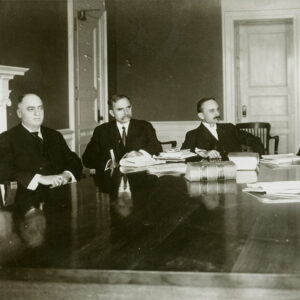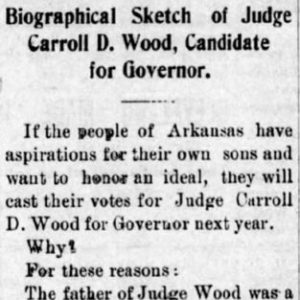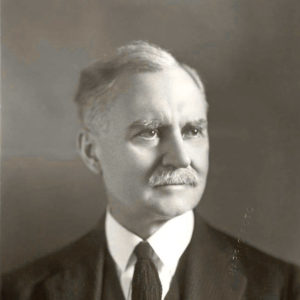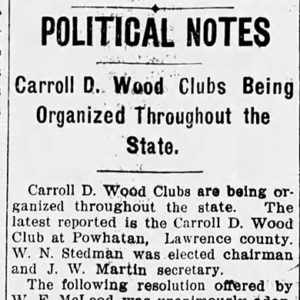calsfoundation@cals.org
Carroll D. Wood (1858–1941)
Carroll D. Wood was an important figure in Arkansas legal history. Although he served on the Arkansas Supreme Court for over thirty-five years, he is arguably best known for his unsuccessful candidacy for governor in 1904.
Carroll D. Wood was born on July 8, 1858, in Ashley County; he was the son of Baptist minister John S. Wood and Martha Bussey Wood; Wood’s mother died when he was very young. The Reverend Wood remarried, and his second wife, Mary Kelsey Wood, provided the future jurist’s earliest education. Wood also attended local Hamburg (Ashley County) schools before pursuing a degree at what is now the University of Arkansas (UA) in Fayetteville (Washington County). Following graduation in 1879, he read law with his older brother and was admitted to the Arkansas bar in 1880. He then settled in Monticello (Drew County); he and another brother began to practice law there.
Wood married Hattie Reola Thompson on November 4, 1886. The couple had three children.
In 1882, Wood was elected prosecuting attorney for the Tenth District, a jurisdiction that included Ashley, Bradley, Chicot, Cleveland, and Drew counties. In 1886, he assumed the position of circuit court judge for the same circuit and was elected to fill the newly created Position No. 4 on the Arkansas Supreme Court in 1893. He served on the court until his retirement in 1929.
As a member of the court, he was known for his quiet competence, wide-ranging knowledge of the law, keen analytical skills, and solid judgement, and the state’s voters reelected him on multiple occasions. However, it was as an adversary of the colorful and powerful governor—and later U.S. senator—Jeff Davis that Wood’s profile was raised among the people of Arkansas. Wood and Davis first clashed in 1902 soon after Governor Davis’s victory in the Democratic gubernatorial primary. Following that victory, Davis removed former Governor James Eagle, then serving as president of the Arkansas Baptist State Convention, from the commission that was overseeing the construction of the new state capitol. Davis, Eagle, and Wood were all members of the Second Baptist Church in Little Rock (Pulaski County), and in April 1902 Wood served on a committee of the church that developed a list of charges against Governor Davis, including public drunkenness, chronic intemperance, and general immoral behavior. The governor denied the allegations and termed the effort a witch hunt, but following a proceeding before the congregation, the church expelled the chief executive from the congregation in May. The following year, anti-Davis forces asked Wood to challenge the governor in the primary election, as the governor had announced his plans to seek an unprecedented third term.
While Wood and Davis had substantive philosophical and stylistic differences, few could have anticipated that the campaign would dissolve into a literal example of bare-knuckle politics. The first incident was in August 1903, when, while sharing a speaker’s platform, Wood responded to an insult by Davis by throwing a punch. The governor dodged the attack but fell off the platform in doing so. Wood was arrested and charged with assault, but the charges were later dropped. A second round came in December. Again sharing a platform, this time it was Davis who resorted to violence. Taking exception to a charge levied by Wood, Davis hit the justice over the head with a gold-topped cane that he had received a few years earlier as a gift from the Arkansas General Assembly. The blow drew blood from Justice Wood’s head and dented the cane’s head. Both men were arrested and convicted of disturbing the peace. In addition, Davis was found guilty of aggravated assault.
While that incident marked the end of the physical clashes, both Wood and Davis continued to conduct energetic campaigns right up to the March primary. While Wood sought to end Davis’s tenure by convincing the state’s voters that he was unfit to hold high office, Davis counterattacked by turning Wood’s moderation, as well as his judicious and responsible approach to governing, on its head, making him appear to be an elite urban operator—and thus a marked contrast to his own tried and true folksy populism.
While observers and local politicians believed that Wood had a chance to oust the incumbent, the Davis forces mobilized in impressive fashion. Wood’s vote exceeded that of previous Davis challengers, but the governor ultimately swept the field, winning just under fifty-eight percent of the vote. Justice Wood, meanwhile, returned to the Arkansas Supreme Court, where he served for another quarter century.
Wood and his wife were living in Little Rock when he retired from the court in 1929. In 1934, he served as chairman for Arkansas Adjustment Board of the National Recovery Administration. He died on December 19, 1941.
For additional information:
Arsenault, Raymond O. The Wild Ass of the Ozarks: Jeff Davis and the Social Bases of Southern Politics. Knoxville: University of Tennessee Press, 1988.
“Carroll D. Wood.” In Centennial History of Arkansas, Vol. 2. Chicago: S. J. Clarke Publishing Company, 1922. Online at http://files.usgwarchives.net/ar/drew/bios/wood453bs.txt (accessed August 25, 2020).
“Ex-Justice Carroll D. Wood Passes.” Arkansas Gazette, December 20, 1941, p. 2.
Stafford, L. Scott. “Supreme Court Justice Carroll Wood.” Arkansas Lawyer 44 (Fall 2009): 26. Online at https://issuu.com/arkansas_bar_association/docs/arkansas-lawyerfall09?mode=embed (accessed August 25, 2020).
William H. Pruden III
Ravenscroft School
 Early Twentieth Century, 1901 through 1940
Early Twentieth Century, 1901 through 1940 Law
Law Politics and Government
Politics and Government Supreme Court Members
Supreme Court Members  C. D. Wood Editorial
C. D. Wood Editorial  Carroll D. Wood
Carroll D. Wood  Carroll D. Wood Supporters Article
Carroll D. Wood Supporters Article 




Comments
No comments on this entry yet.